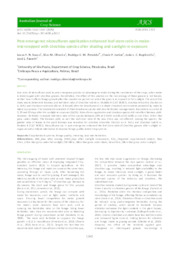Post-emergence nicosulfuron application enhanced leaf-stem ratio in maize-intercropped with Urochloa species after shading and sunlight re-exposure.
Post-emergence nicosulfuron application enhanced leaf-stem ratio in maize-intercropped with Urochloa species after shading and sunlight re-exposure.
Author(s): SOUZA, L. F. N.; OLIVEIRA, S. M.; ALMEIDA, R. E. M.; PIEROZAN JUNIOR, C.; BAPTISTELLA, J. L. C.; FAVARIN, J. L.
Summary: Low rates of nicosulfuron used in post-emergence provide an advantage to maize during the coexistence of the crops, when maize is intercropped with Urochloa grasses. Nonetheless, the effect of this practice on the morphology of these grasses is not known, neither how it affects forage growth after the coexistence period nor when the grass is re-exposed to full sunlight. The aim of this study was to determine biomass and leaf-stem ratio of Urochloa hybrid cv. Mulatto II (CIAT 36087), Urochloa brizantha (Hochst. ex A. Rich.) and Urochloa ruziziensis (Germ. & Evrard) after the development in a shade simulated environment promoted by maize in intercrop systems. The treatments consisted of three brachiaria species with two herbicides managements. Evaluations occurred at 0, 30 and 60 days after the sunlight re-exposure (DASR). Nicosulfuron application and Urochloa species did not affect biomass yield. However, herbicide increased leaf-stem ratio of the species between 25% at 0 DARS to 62% at 30 DARS on old tillers (tillers that grew under shade). The biomass yield, as well the leaf-stem ratio of the new tillers was not affected. Among the species, the greater ratio of leaves in the plant biomass was recorded for Urochloa brizantha (Hochst. ex A. Rich.) and Urochloa hybrid cv. Mulatto II (CIAT 36087). Nicosulfuron use in post-emergence enhanced the leaf-stem ratio of Urochloa grasses after sunlight re-exposure and a reliable alternative to improve forage quality in intercrop systems.
Publication year: 2020
Types of publication: Journal article
Observation
Some of Embrapa's publications are published as ePub files. To read them, use or download one of the following free software options to your computer or mobile device. Android: Google Play Books; IOS: iBooks; Windows and Linux: Calibre.
Access other publications
Access the Agricultural Research Database (BDPA) to consult Embrapa's full library collection and records.
Visit Embrapa Bookstore to purchase books and other publications sold by Embrapa.

